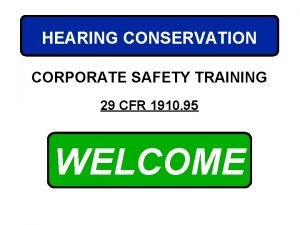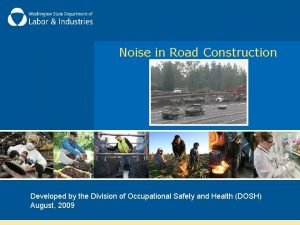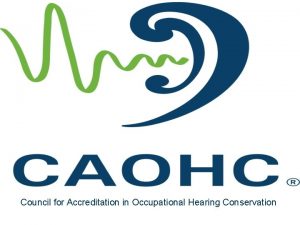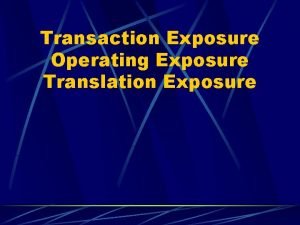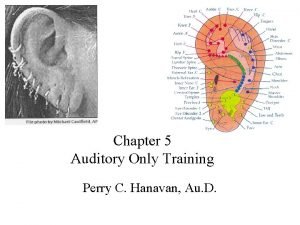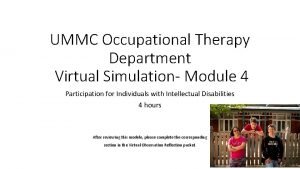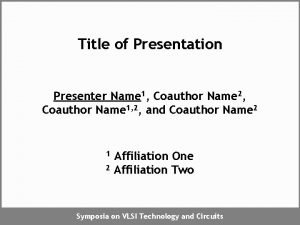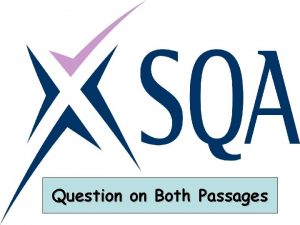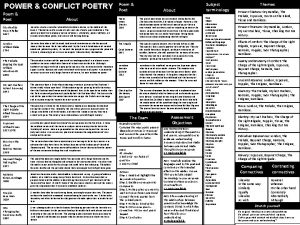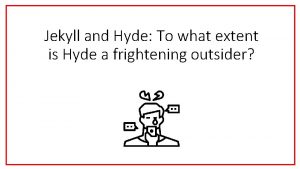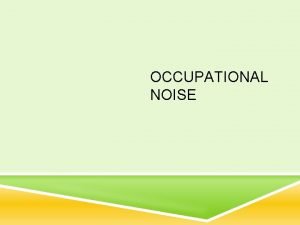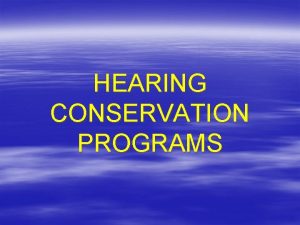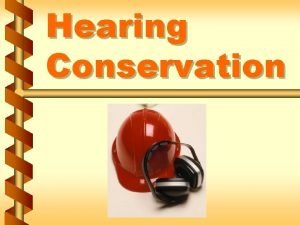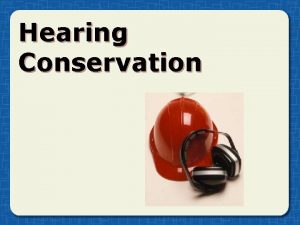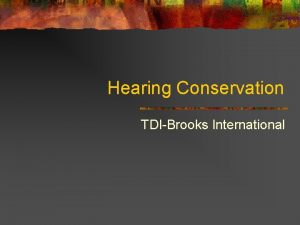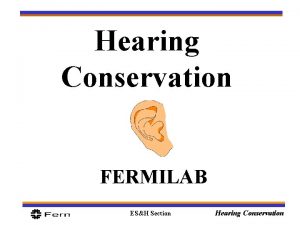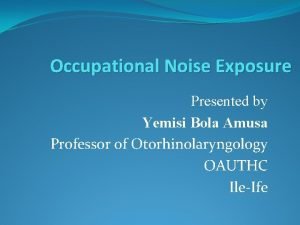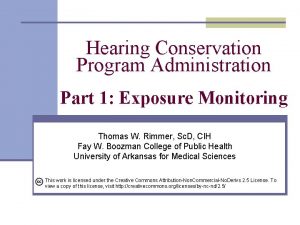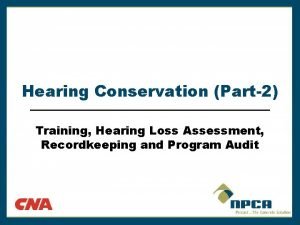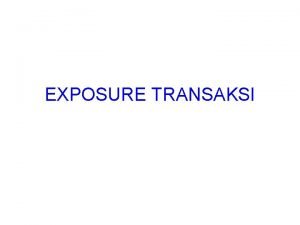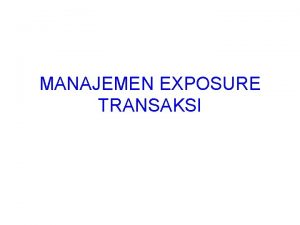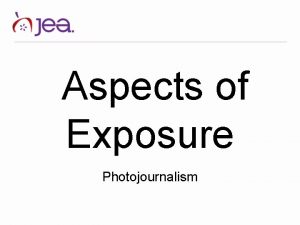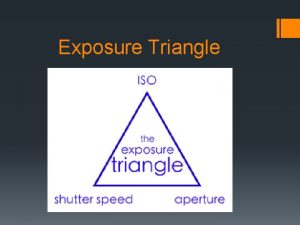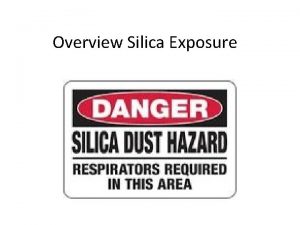Occupational Noise Exposure Hearing Conservation Training Program Presented




















- Slides: 20

Occupational Noise Exposure Hearing Conservation Training Program Presented by ECU Office of Environmental Health and

Did You Know? About 30 million workers are exposed to hazardous noise on the job Noise-induced hearing loss is the most common occupational hazard for American workers Hearing loss from noise is slow and painless; you can have a disability before you notice it If you must raise your voice to speak with someone only 3 feet away, you are in high (hazardous) noise. It is 100% preventable Source Noise and Hearing Loss Prevention | NIOSH | CDC.

What is Noise? Noise is any unwanted sound By-product of many industrial processes, e. g. operating machinery Exposure to high levels of noise may lead to hearing loss and other harmful health effects

General Estimate of Work. Related Noises Source: NIOSH

Common Sounds may be louder than you think …

Anatomy of the Ear Containing the vestibule, semicircular canals, and the cochlea. Region where damage that causes hearing loss occurs

Signs of Hearing Loss Do you ask people to speak louder so that you can hear? Do you have to turn the TV or Radio so loud that others complain?

Hearing Loss • Temporary Hearing Loss -results from short term exposure to noise -hearing returns when away from the noise • Permanent Hearing Loss - results from exposure to a moderate or high level of noise over a long period of time -hearing loss is PERMANENT

Selection of Hearing Protection Devices • Hearing protection devices are selected according to: – – – • Employee comfort Level of noise exposure NRR of device Type of work being performed Environmental conditions Employee may select hearing protection from a variety of suitable hearing protectors provided by employer.

Types of Hearing Protection Devices Ear muffs Foam insert earplugs Semi-aural earplugs Earmuffs Earplugs Ear caps or bands

Ear Muffs • • • Advantages More protection at higher frequencies than earplugs Various NRRs available Durable, long lasting Can be fitted on hard hat Reusable • • Disadvantages Higher cost Eye glasses can interfere with ear muff seal May be uncomfortable in hot environments Must be cleaned before use by another worker

Foam Insert Earplugs Advantages More protection at lower frequencies than muffs Various NRRs available Inexpensive; disposable Can be custom molded for individual worker Reusable plugs are available • • Disadvantages Hands must be cleaned before inserting earplugs Improper insertion reduces NRR value

Semi-aural Caps Advantages Various NRRs available Easy to insert May be used several times Ideal for people going in and out of noisy areas Disadvantages Improper insertion reduces effectiveness More expensive than ear plugs Typically have lower NRRs than plugs or muffs

Fit, Use and Care of Hearing Protection Devices Employer must ensure proper initial fitting Employer must supervise the correct use of hearing protectors Hearing protectors must be replaced as necessary at no cost to employee, contact your supervisor Hearing protection devices must be cleaned and stored according to the manufacturer’s specification For questions concerning selection of hearing protection based on NRR and proper fit contact EH&S @ 328 -6166

Audiometric Testing Monitors employee’s hearing over time Baseline audiogram must be performed within first 6 months of work exposure ( 8 hour TWA ≥ 85 d. BA) Annual audiograms are required each year after baseline audiogram Employer must pay for the cost of each required audiogram

Why Do Audiometric Testing? Obtain a Baseline Audiogram for future comparison Identify occupational hearing loss Identify Standard Threshold Shifts (STS) An STS is an average shift in either ear of 10 d. B or more at 2, 000, 3, 000, and 4, 000 hertz.

Normal Vs Noise-Induced Audiometric Testing?

Access to Information and Training Materials A copy of the OSHA 29 CFR 1910. 95 standard available to affected employees online @ www. osha. gov OSHA Occupational noise exposure standard must be posted in the workplace Employer is responsible for record keeping regarding employee noise exposure measurements for 2 years. However, the audiometric test records are kept for the duration of employment of the employees who are in the hearing conservation program.


To receive credit for this training please complete the linked QUIZ Questions 211 South Jarvis Street, Suite 102, Greenville NC 27858 Online: www. ecu. edu/oehs Email: safety@ecu. edu Phone: (252) 328 -6166
 Hearing conservation program audit checklist
Hearing conservation program audit checklist Hearing conservation program dosh
Hearing conservation program dosh Caohc certification
Caohc certification Managing economic exposure and translation exposure
Managing economic exposure and translation exposure Translation exposure
Translation exposure How to manage economic exposure
How to manage economic exposure Managing economic exposure and translation exposure
Managing economic exposure and translation exposure Noise
Noise Lace hearing training
Lace hearing training Alert program occupational therapy
Alert program occupational therapy Ummc occupational therapy program
Ummc occupational therapy program Sustainable agricultural lands conservation program
Sustainable agricultural lands conservation program Cross line headline example
Cross line headline example Name/title of presenter
Name/title of presenter Jekyll and hyde quotes
Jekyll and hyde quotes Theme of love in romeo and juliet
Theme of love in romeo and juliet Which fact is mentioned in both passages
Which fact is mentioned in both passages Name of presenter
Name of presenter How is power presented in ozymandias
How is power presented in ozymandias Cognitive learning theory by jerome bruner
Cognitive learning theory by jerome bruner How is hyde presented as a frightening outsider
How is hyde presented as a frightening outsider
